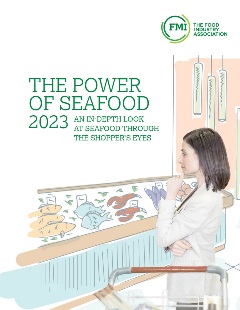“Power of Seafood 2023” Offers In-Depth Look at Seafood Buying Habits
 ARLINGTON, VA — FMI – The Food Industry Association today released the Power of Seafood 2023 report, revealing seafood department sales totaled $16.2 billion in 2022, a 3.8% decrease over 2021 as inflation raised the prices of fresh and frozen seafood.
ARLINGTON, VA — FMI – The Food Industry Association today released the Power of Seafood 2023 report, revealing seafood department sales totaled $16.2 billion in 2022, a 3.8% decrease over 2021 as inflation raised the prices of fresh and frozen seafood.
The drop in sales reversed an upward trend that featured record sales during the COVID-19 pandemic, although seafood sales were still higher in 2022 than in 2019, driven in part by shoppers’ desire to both eat healthier and include more environmentally friendly options in their diet.
“Inflationary price increases certainly had a negative impact on the sale and consumption of seafood in 2022, with many shoppers turning to more affordable proteins as they adjusted their spending habits to the economic environment,” said Rick Stein, vice president for fresh foods at FMI. “However, seafood sales were up compared to 2019 despite elevated prices, indicating that shoppers who became more comfortable cooking seafood during the pandemic continue to appreciate the health benefits of preparing seafood at home. Given shoppers increasing interest in health and well-being, adding more variety to their diet, and eating more sustainable foods in general, we expect the category to rebound once inflationary pressures ease.”
The Power of Seafood 2023 is FMI’s fifth in-depth look at seafood consumption and buying habits through shopper’s eyes. Key findings include:
Fresh Versus Frozen Seafood
Fresh seafood sales fell to $6.5 billion in 2022 from 2021’s $7.1 billion. Frozen seafood sales, lower than fresh in 2019, began outpacing fresh seafood sales in 2020, but also declined in 2022 to $7.1 billion, down 2.8% from the previous year.
Fewer Frequent and Occasional Seafood Consumers
Power of Seafood 2023 finds 53% of shoppers are frequent (two or more times a week) or occasional (once a month to one time a week) seafood consumers, down from 2021 (59%). Fifty-five percent of these consumers are cooking seafood more often and are more comfortable doing so since the pandemic (47%).
Those choosing to eat seafood frequently say nutrition and health (81%) are the primary, or an important reason, they do so.
Protein Preferences
Poultry, meat and pork still reign when it comes to the protein preferences of shoppers, with consumers purchasing these foods more than twice as often as seafood. When shoppers surveyed were asked to choose protein options if all prices were the same, 25% would choose seafood over other protein types. However, still more shoppers would choose chicken (32%) or beef (33%) if protein prices were equal.
Cooking Seafood at Home Versus Eating Out
Consumers prepare and eat most of their seafood at home (53%), with 13% buying seafood partially or fully prepared at the grocery store while 14% purchase take out from a restaurant to eat at home, and 20% order seafood while dining at a restaurant.
Seafood and Sustainability
Seafood consumers have growing preferences for farm-raised (20%) and wild-caught (45%), however, many are not always sure what the terms mean. Forty-three percent either partially understand or are not sure what wild-caught means; 51% are not clear what farm-raised means; and 71% don’t understand the term aquaculture.
ABOUT THE REPORT
The Power of Seafood 2023 was conducted by FMI and made possible by Alaska Seafood, Cargill, and Riverence.
For Media:
- Members of the media may contact FMI for a gratis copy of Power of Seafood 2023.
 Industry Topics address your specific area of expertise with resources, reports, events and more.
Industry Topics address your specific area of expertise with resources, reports, events and more.
 Our Research covers consumer behavior and retail operation benchmarks so you can make informed business decisions.
Our Research covers consumer behavior and retail operation benchmarks so you can make informed business decisions.
 Events and Education including online and in-person help you advance your food retail career.
Events and Education including online and in-person help you advance your food retail career.
 Food Safety training, resources and guidance that help you create a company food safety culture.
Food Safety training, resources and guidance that help you create a company food safety culture.
 Government Affairs work — federal and state — on the latest food industry policy, regulatory and legislative issues.
Government Affairs work — federal and state — on the latest food industry policy, regulatory and legislative issues.
 Get Involved. From industry awards to newsletters and committees, these resources help you take advantage of your membership.
Get Involved. From industry awards to newsletters and committees, these resources help you take advantage of your membership.
 Best practices, guidance documents, infographics, signage and more for the food industry on the COVID-19 pandemic.
Best practices, guidance documents, infographics, signage and more for the food industry on the COVID-19 pandemic.
